Coronavirus (COVID-19) volunteering - third sector perspectives: survey report
Findings from a survey undertaken to gather insights into the experiences of Scottish third sector organisations and other stakeholders involved in supporting volunteering during the pandemic.
5 Management and coordination of the volunteering response
We asked survey respondents about their views on how well the volunteering response was managed and coordinated in their local areas as well as nationally, and what could have been improved. We also explored the extent to which infrastructure organisations were aware of resilience arrangements before the pandemic, and whether they had been able to get involved in these during the pandemic. Finally, we asked respondents to share their views on the Scotland Cares campaign, the national volunteer recruitment campaign that was launched at the start of the pandemic.
5.1 Coordination of local volunteering responses
There were many different partners involved in the coordination of local volunteering responses during the pandemic. The number of institutional partners involved, and the fast pace of developments – particularly the groundswell of new community based volunteering efforts that emerged quickly at the beginning of the first lockdown – made coordination a challenging and confusing effort for many organisations.
While in some areas, volunteering coordination was in place from the start of the pandemic, other respondents indicated that initially the situation was quite confusing – particularly given the proliferation of new groups and initiatives seeking to help out – and that the local coordination took time to get in place.
'At the start of the pandemic we organised a keep calm and co-ordinate group to bring together our public sector and local organisations in a collaborative response to the emergency response. This resulted in the creation of… a single telephone number for local people, groups and organisations to call to offer help, ask for help or find out what is happening in [Local Authority area].'
'During the first lockdown and early part of the pandemic there was very much an 'emergency response' from individuals, communities and organisations with people just trying to organise themselves to act as quickly as possible to help and protect those in need and vulnerable and the demand in the first lockdown was around getting basic supplies and supports to people and to preserve life and reduce harm.
As things progressed beyond the initial few weeks there was greater consideration given to joint planning, making best use of volunteer resource and ensuring volunteers themselves were protected and able to work as safely as possible. This meant that by the end of first full lockdown and into second lockdown certain services and activities were better organised across the voluntary and public sector and less 'reactive' and with clearer support processes and procedures in place for individuals and organisations the demand balanced out.'
Several respondents felt that the most successful responses were ones that integrated a high level of coordination between different actors. This tended to be easier in places where community support groups had strong links to pre-existing organisations which in turn had established relationships with other key partners in the local area.
5.1.1 How infrastructure organisations rated the coordination of the volunteering response
Coordination of the local volunteering response became an important role for many infrastructure organisations. Ninety-four percent of all infrastructure organisation respondents said that they led coordination of volunteering responses to some or to a large extent (Figure 4.6 above).
Infrastructure organisations were asked to rate the coordination of the volunteering response between key partners. As shown in Figure 5.1, infrastructure organisations rated the coordination of the response between themselves and key local partners the highest, with 48% of respondents saying this was excellent, and 31% saying it was good. Coordination between the local authority and the TSI was also fairly highly rated, with 37% saying this was excellent, and 38% saying it was good. Infrastructure organisations rated coordination between themselves and national partner organisations somewhat less favorably, with 50% of respondents considered the coordination with national partners to be either excellent or good; 37% saying that there had been limited coordination at this level, and 8% saying there had been no coordination. It was clear from the responses that coordination was felt to be most effective – and arguably made the most difference – at the local authority and local levels.
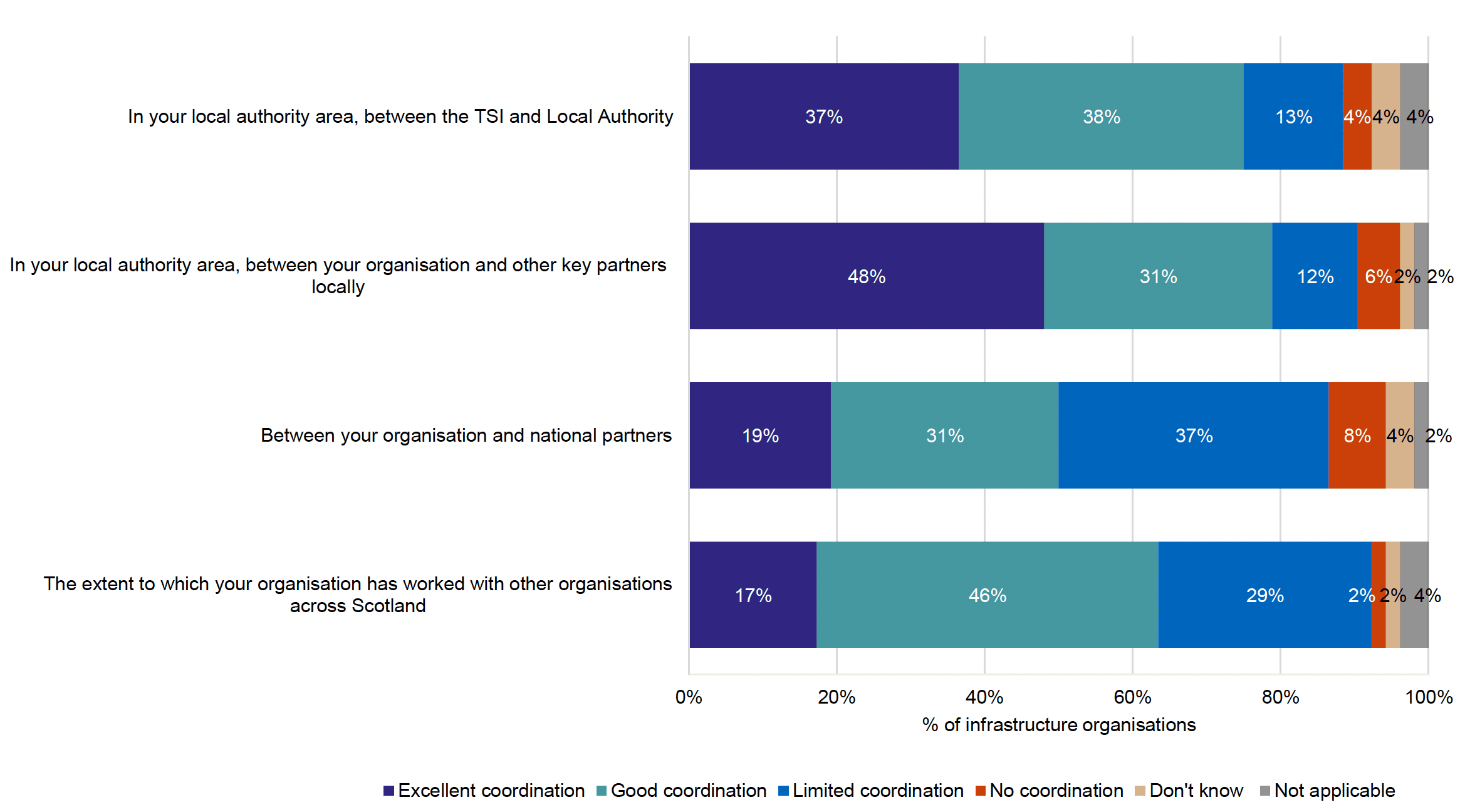
The main predictor of good coordination seemed to be strong or effective pre-existing working relationships between key local partners – particularly the local authority and TSI – which helped to underpin a more inclusive multi-agency approach to the COVID-19 response. Of the 38 infrastructure respondents who gave examples of what had worked well in the coordination response, 27 talked about the multiagency response. Whilst some were able to draw on pre-existing relationships, others felt that positive working relationships and coordination structures developed as a result of the pandemic, and that this was a helpful outcome that would support better planning and coordination through the next stages of recovery.
'There has been excellent co-operation and co-ordination between the TSI's Volunteer Centre and the local authority and HSCP to provide an effective, comprehensive and robust volunteer response to help people with mild to moderate needs as well as those requiring high levels of assistance.'
'What worked especially well was when community response volunteers came across individuals who were not registered with health or social care as 'vulnerable', but who were identified as such by the volunteers. The response and co-ordination with health and social care was very good.'
Infrastructure organisations were also asked what aspects of the coordination of the volunteer response could have been improved. Responses to this question focused on two main areas: the coordination between local authorities, TSIs and other third sector organisations; and the coordination of the Scotland Cares campaign between national and local levels. Local authorities were more likely to focus on the coordination between local authority and national level, while TSIs talked more about coordination with other local statutory partners.
Whilst multi-agency working worked well in many places, there were clearly some areas where there was more difficulty, particularly in building strong coordination between the work of the TSI and the local authority.
'There was little to no coordination of the local volunteer response. It was made pertinently clear by the local authority from the onset that they had no respect for existing relationships, processes and systems which the TSI had already in place due to its role in supporting volunteering in pre-COVID times. Rather than working with us, they further complicated the landscape by adding their own processes.'
'Local coordination and recruitment of volunteers could have been more efficient. Initial discussion between [TSI] and local authority were to have a joint response to a local volunteer support phone line and matching of volunteers to local response groups, however, the local authority decided to keep this in-house due to their concerns regarding info sharing. From subsequent feedback, the response could have been improved by increased partnership coordination to ensure consistency in the volunteer response and avoid duplication of work.'
The coordination of the Scotland Cares campaign is covered in more detail in Section 5.3.
5.1.2 How VIOs rated the coordination of the volunteering response
VIOs were also asked to rate the coordination of the volunteering response (Figure 5.2). While 47% rated coordination of the response as good or excellent, 26% felt that coordination was limited/could be improved, with 6% saying there was no coordination of the volunteering response in their view, and 21% saying either that they didn't know, or that the question was not applicable to them.
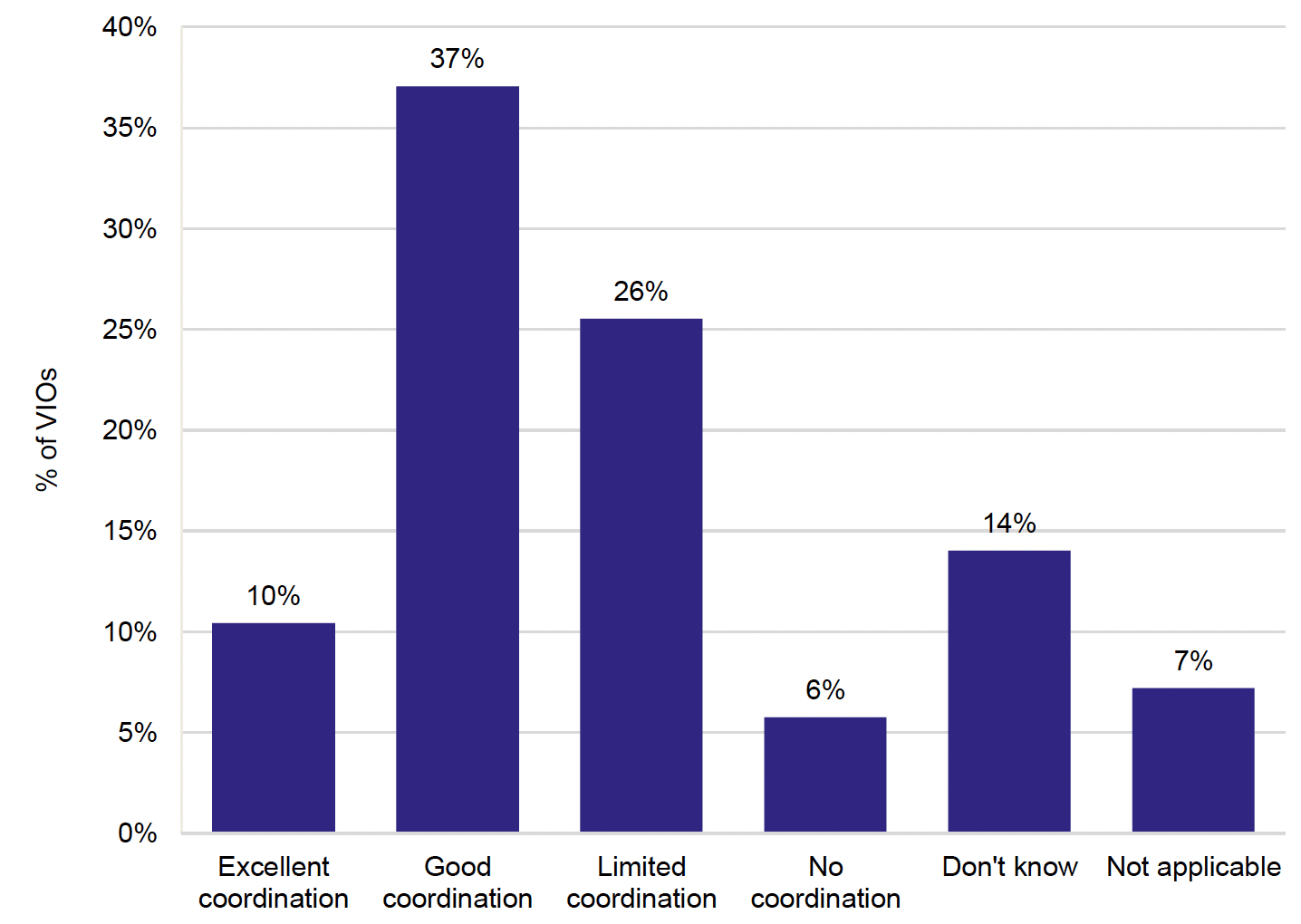
Where VIOs felt coordination worked well, it was usually due to the actions of either the local TSI, local authority or both, in putting effective coordination structures in place and engaging well with local third sector organisations.
'The coordination from the local hub (local authority) in the [area] during lockdown was exemplary, they responded quickly and brought in the local, on-the-ground third sector organisations to help. I believe we worked well together and were therefore able to offer support to the more vulnerable in the community.'
'Food network established to coordinate local response to ensure groups supported each other and avoided duplication. Council established neighborhood hubs and linked with third sector. Supporting Communities Fund … ensuring quick and easy response for community groups. Successful projects were linked together improving delivery for community.'
Among the VIOs that would have liked more coordination, many cited difficulties in knowing which organisations to contact and felt that there had been limited or no communication or information to support volunteering coordination in their area.
'I think organisations could have been better at "sharing" volunteers, particularly where normal activity had to cease. I also believe that much of the emergency response was provided by community based organisations who didn't have appropriate knowledge of the sector to effectively link up. This has been a key role for TSIs who have often done a fantastic job in coordinating new and existing services. I think the Scotland Cares campaign confused this response, and wasn't joined up with demand/need for volunteers at a community level.'
'It was very difficult to get information about other services, including the local authority. We had nowhere to refer vulnerable people and nowhere to report any problems people were facing. This improved slowly over the course of the first lockdown and by the second lockdown, it was a bit easier. There is no one-stop shop to get info and no one was carrying out online training to help us figure out where people could get help.'
Overall, while many of the responses expressed challenges around coordination, many infrastructure organisations and VIOs suggested that coordination within local authority areas generally improved during the course of the pandemic, and that better coordination structures and working relationships could be an important legacy with the potential to support volunteering and other aspects of local response in the future.
5.2 Awareness and involvement in resilience planning
We asked infrastructure organisations about their levels of awareness and involvement in resilience planning prior to the pandemic. As shown in Figure 5.3, the responses suggested there was a lot of variation between infrastructure organisations in terms of how aware or involved they had been in resilience planning prior to the pandemic. As would be expected, local authorities generally rated their awareness and involvement in resilience planning as high: 91% of the local authority respondents said their awareness of resilience planning before COVID-19 was high or very high, while 82% said their involvement in resilience planning prior to COVID-19 was high or very high. In contrast, TSIs varied greatly in their levels of awareness and involvement in resilience planning and partnerships prior to the pandemic – from very high to none. Of the TSI respondents, 25% rated their prior awareness of resilience planning as high, while 14% rated their prior involvement as high or very high. Overall, 58% of respondents rated their awareness of resilience planning as prior to the pandemic as 'very high', 'high', or 'some' (58%). Conversely, 37% rated their level of awareness as 'limited' or 'none' (37%).
While TSIs and the third sector became more integrated in resilience structures in some areas during the pandemic, this continued to be more of a challenge in others.
'We were disappointed not to be involved in our local Resilience Partnership. It would appear there was a different approach across Scotland where some TSI's were heavily involved and others not involved at all.'
'The resilience response felt effective but again could have been improved with more third sector inclusion. Although we eventually were seen as full and effective partners in the Local Response Management Team structure, we were firstly overlooked and in fact turned away from a meeting as it was deemed 'too early' for our involvement.'
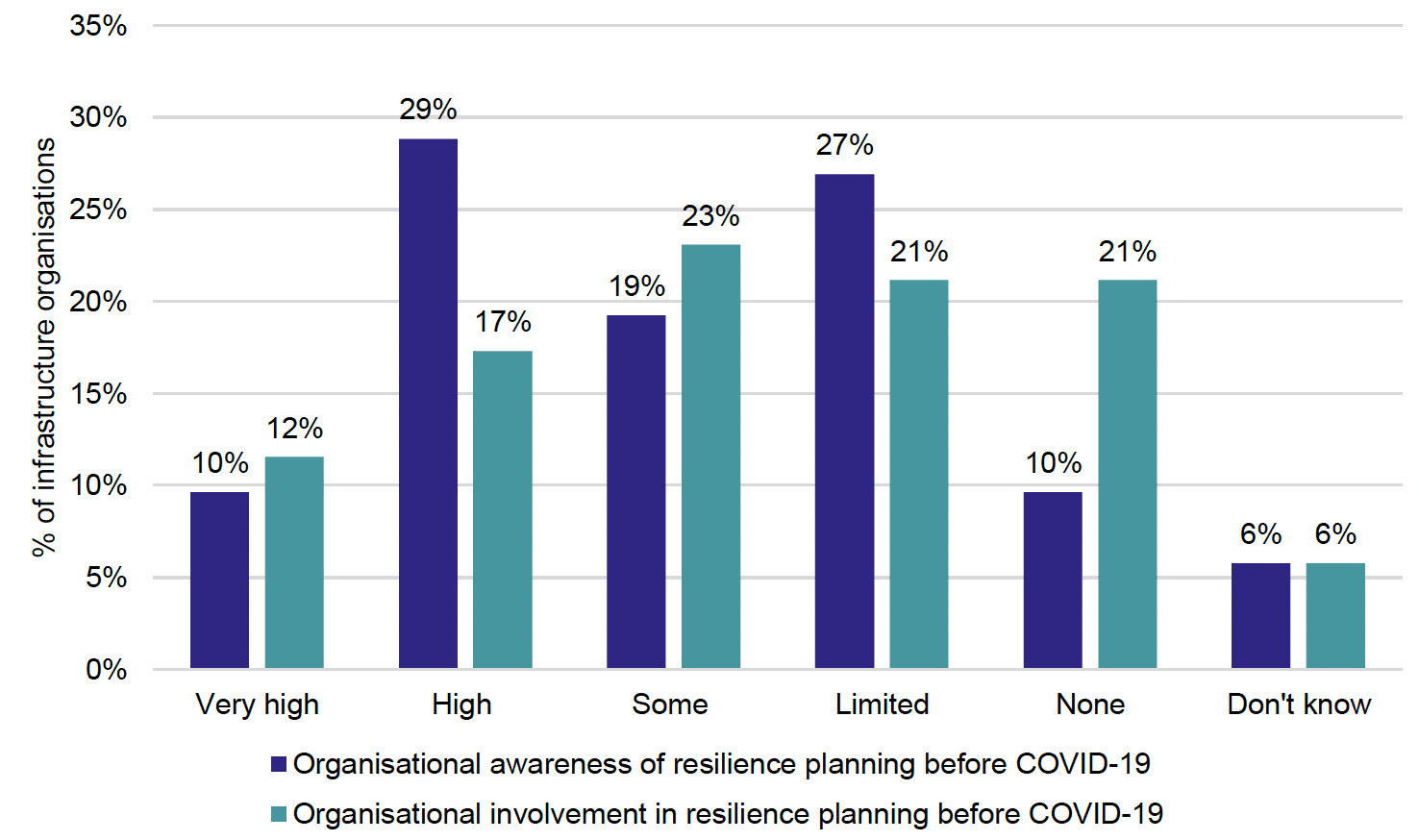
A few respondents considered that the focus of resilience planning arrangements prior to the pandemic had been more on structures, pipelines and 'hardware' aspects of resilience, with less focus on community response and the role it might play in a crisis. Others noted that preparedness arrangements had focused more on potential environmental crises – such as flooding – with the implication that resilience arrangements needed more adaptation to cope with the specific demands of the pandemic.
'The resilience response was effective at coordinating the 'structural' aspects of the pandemic – i.e. planning for hospital beds, vaccines, mortuary back up-procedures. However at the beginning of the pandemic it was insufficiently linked to the community response. Third Sector organisations that typically were involved in the resilience partnerships were not, in most cases, at the forefront of the community response. The community response was coordinated by the LA and TSI. We have since improved communication between the voluntary sector resilience partnership and the TSI.'
'The community resilience response in most areas was very effective but could have been more streamlined/joined up. From the statutory services, it would have been better if they didn't use the plans for flooding, heavy snow etc. as a base to work from. Better communication and again a better understanding and valuing of the third sector input.'
Some respondents also noted that the nature of existing resilience planning arrangements had changed as a result of the pandemic, arguably developing a greater focus on social aspects of resilience, including community volunteering, as well as building closer relationships with the third sector. There was a feeling that this is an important gain that can be built on for future responses, and also that the pandemic has generated useful lessons for resilience arrangements in Scotland.
'We need to distinguish between resilience in the face of emergencies and resilience to chronic stresses and ongoing systemic challenges. The city's resilience strategy had previously looked to address both and had identified the importance of community leadership for both (leaders in both paid and unpaid roles) but I'm not clear that the emergency planning structures had learnt from that nor examined the extent to which they needed to expand their membership to take account of it.'
'During COVID-19 the resilience response was excellent and very effective. There is greater awareness of resilience and more people/organisations are now involved in continuing to actively build community resilience.'
'We have a strong community planning partnership in [Local Authority area] – and the resilience response, such as we've seen during the COVID-19 crisis, saw [Local Council], the Health & Social Care Partnership, local private sector organisations, and the Third Sector network of community groups shape the local response to a national crisis - often providing a 'safe place' for those vulnerable individuals and families most at risk.
While we believed that the existing work in [Local Authority area] provided a great starting point for meeting the increased needs felt by our communities during the crisis, the resilience response has perhaps actually strengthened the collaborations, and existing partnerships. There is also appears to be a willingness to the idea shaped by the Social Renewal Advisory report to 'Build on new ways of working, based on what has worked well during the pandemic'.'
5.3 The Scotland Cares campaign
The Scotland Cares campaign was a national volunteering campaign that ran between March-May 2020, right at the beginning of the pandemic. The campaign was put in place by the Scottish Government in partnership with NHS Scotland, Volunteer Scotland and the British Red Cross. The intention was to ensure that a large pool of volunteers could be identified to be called upon to support the COVID response at community level as needed, and who could be appropriately supported in a coordinated way. The campaign was a response to the widespread public impetus to volunteer in some way, and the need to be able to channel this 'spontaneous' volunteering effectively without creating additional burden for operational services.[12]
The campaign encouraged potential volunteers to sign up with either the British Red Cross or Volunteer Scotland, in order to support the COVID-19 response in Scotland. The campaign also encouraged former health professionals to return to the NHS. By May 2020 the campaign had gathered over 83,000 sign-ups, more than 60,000 of which were with Volunteer Scotland (35,262) or the British Red Cross (25,172).[13]
The British Red Cross made direct contact with the potential volunteers, encouraging them to register as community reserve volunteers and download the 'GoodSam' app, an app designed to match volunteer tasks – such as patient transport – with volunteers in the relevant local area.
Volunteer Scotland also made direct contact with all of the potential volunteers signing up on their platform, however the mobilisation of volunteers signing up on the Volunteer Scotland platform was intended to take place via local authority-based volunteering management structures – not via Volunteer Scotland directly. Accordingly, Volunteer Scotland contacted the representatives of TSIs and local authorities in every local authority area, and provided the local authority/TSI volunteering leads with details of the potential volunteers in their local area. It was then up to the local volunteering coordination structure to make further contact with the potential volunteers, encouraging them to register to receive further information about local volunteering opportunities.
Of the 39 local authorities and TSIs responding to this survey, 35 (90%) said they had received data relating to relevant sign-ups to the Scotland Cares campaign. These organisations took various steps to make contact and follow up with the people signing up to the Scotland Cares campaign, including:
- Registering them with their own organisation (63% of the infrastructure organisations did this);
- Informing relevant volunteering organisations in the local area about the availability of potential volunteers (60% did this);
- Matching volunteers to organisations needing volunteers (63% did this);
- Sending regular communications about volunteering in the local area to those people who had signed up and registered (63% did this).
5.3.1 Views on the campaign
We asked infrastructure organisation respondents to tell us their views about the Scotland Cares campaign, focusing on what worked well within the campaign, and what could have been improved.
Some respondents recognised that the campaign had been successful in raising the profile of volunteering, generating a huge positive response from large numbers of people, including people who were new to volunteering and groups that would probably not have been reached otherwise. According to one infrastructure organisation:
'The Scotland Cares campaign was excellent and very effective in helping build the tremendous volunteering and community response to COVID-19. It successfully harnessed people's desire to help and the link between the national campaign and local action was great.'Respondents also acknowledged the success of the campaign in generating interest and sign-ups from people with a wide range of skills and experience.
'The range of skills offered by volunteers gave organisations a level of choice not usually available.'
However, the overwhelming opinion among the infrastructure organisations was that the volunteering campaign had led to large numbers of people signing up for whom there were not enough formal volunteering roles available. It was not possible for the infrastructure organisations and their third sector partners to place the majority of the volunteers into roles. As shown in Figure 5.4:
- just 17% of infrastructure organisations agreed that 'most people who wanted to found volunteering opportunities'
- 48% agreed that there were significantly more volunteers than it was possible to place
- 23% said that there were 'somewhat' more volunteers than they could place.
'It energised people to volunteer, which would have been good if we needed them but as it turned out we really only needed a few.'
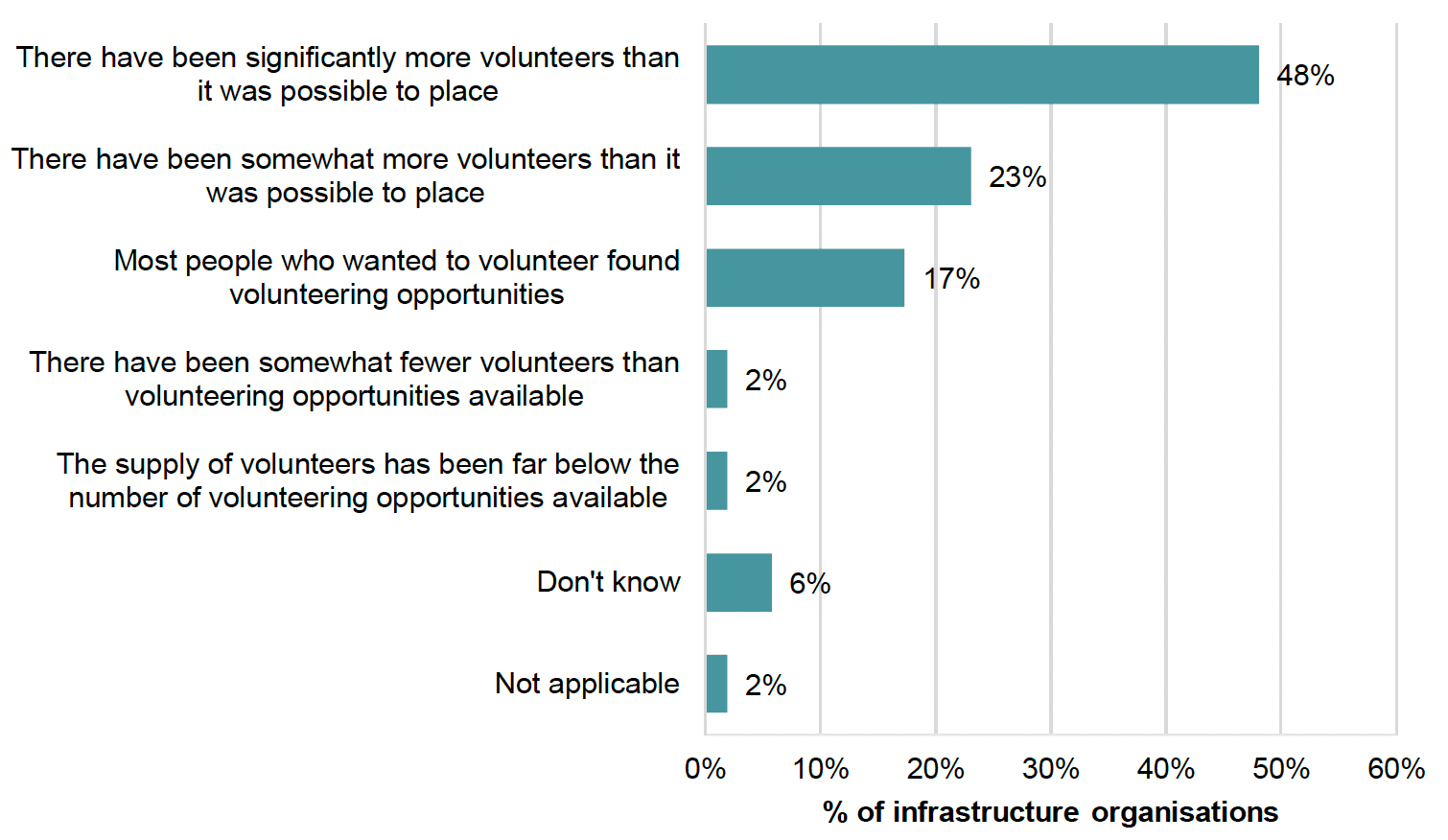
Once they received the details of sign-ups to the campaign in their local areas, infrastructure organisations (mainly TSIs) typically contacted the people who had signed up to the national campaign to invite them to register with the local volunteering platform, and to share information about local volunteering opportunities. Respondents felt that this double sign-up/registration process was off-putting to people, and created an additional barrier.
'The promotion and the numbers signing up were fantastic. It felt a bit disjointed with volunteers signing up via a national intermediary to then be passed to the local organisation to deal with. We then had to ask them to register with us which was another exercise and for some could be seen as a barrier. We had to then look at the limited opportunities we had available and try our best to match the skills with the right organisation.'
The influx of willing volunteers combined with a lack of volunteer roles locally was a cause of concern to respondents from infrastructure organisations, who felt that there needed to be better management of expectations around volunteering opportunities – with the result that many potential volunteers were disappointed.
'I think that what Scotland Cares showed was that there were/are huge numbers of people who are willing to volunteer. There seemed to be a mismatch between people coming forward and being matched up with volunteering opportunities, many people who came forward received very little communication and were left feeling unvalued.'
'I appreciate the good intentions behind the campaign, but it was pretty disastrous for volunteering. There was no coordination with the TSI, so there was no management of the expectations of the number of volunteering opportunities that would be available. We received over a year's worth of volunteers in one go – there was no way we were going to be able to place more than a fraction of them. This resulted in a lot of disappointed volunteers, who couldn't understand why the Government was encouraging them to volunteer, but we were telling them we couldn't place them. This resulted in reputational damage to our organisation, and may mean that people are less likely to volunteer in future. It was very difficult to get our voices heard – we were telling the Government that we couldn't cope with all the volunteers that were coming through, but they kept advertising the campaign.'
Respondents particularly felt that there had been a lack of coordination between the national campaign and the local volunteering coordination leads in the TSIs in particular. In some areas, TSIs had already run volunteer promotional campaigns; in others, mutual aid responses were already well underway. There was a feeling that the Scotland Cares campaign came too late, and did not reflect the level of locally-expressed needs for volunteers.
'It would have been helpful if there had been some consultation with local TSIs who could have advised on the greatly reduced number of opportunities available. A great many volunteers were disappointed at not being offered a role and potentially discouraged their future volunteering.'
'The numbers who registered was positive, however we already had more than sufficient volunteers who registered with our local campaign therefore the end result was duplication and an additional strain on capacity to contact those who had registered on Scotland Cares. The most significant improvement would have been engagement locally prior to any national campaign.'
Respondents also noted that there were difficulties in coordination between the two volunteering sign-up pathways (British Red Cross and Volunteer Scotland). Data management and the additional data-processing workload created by the campaign was also a concern.
'We were fortunate to have a digital system in place where volunteers could register themselves, upload their own information, and submit their own requirements and any additional information. If we had been reliant on manually sourcing and inputting volunteer information we would have been completely overwhelmed. Options for data management weren't presented to TSIs and it was understood that each TSI should manage the data as best they could, while also adhering to GDPR and their existing procedures.'
5.3.2 Volunteer deployment arising from the campaign
Because the people who signed up via the Volunteer Scotland platform were subsequently linked with local authority-level volunteering coordination structures across Scotland, we do not have a single source of data on the numbers that were subsequently deployed as volunteers. We asked respondents to estimate what proportion of the people who signed-up in their area went on to volunteer with an organisation. As shown in Figure 5.5, 50% of infrastructure organisations said that 25% or fewer of the people who signed up went on to volunteer. Thirty-one percent of respondents said they didn't know.
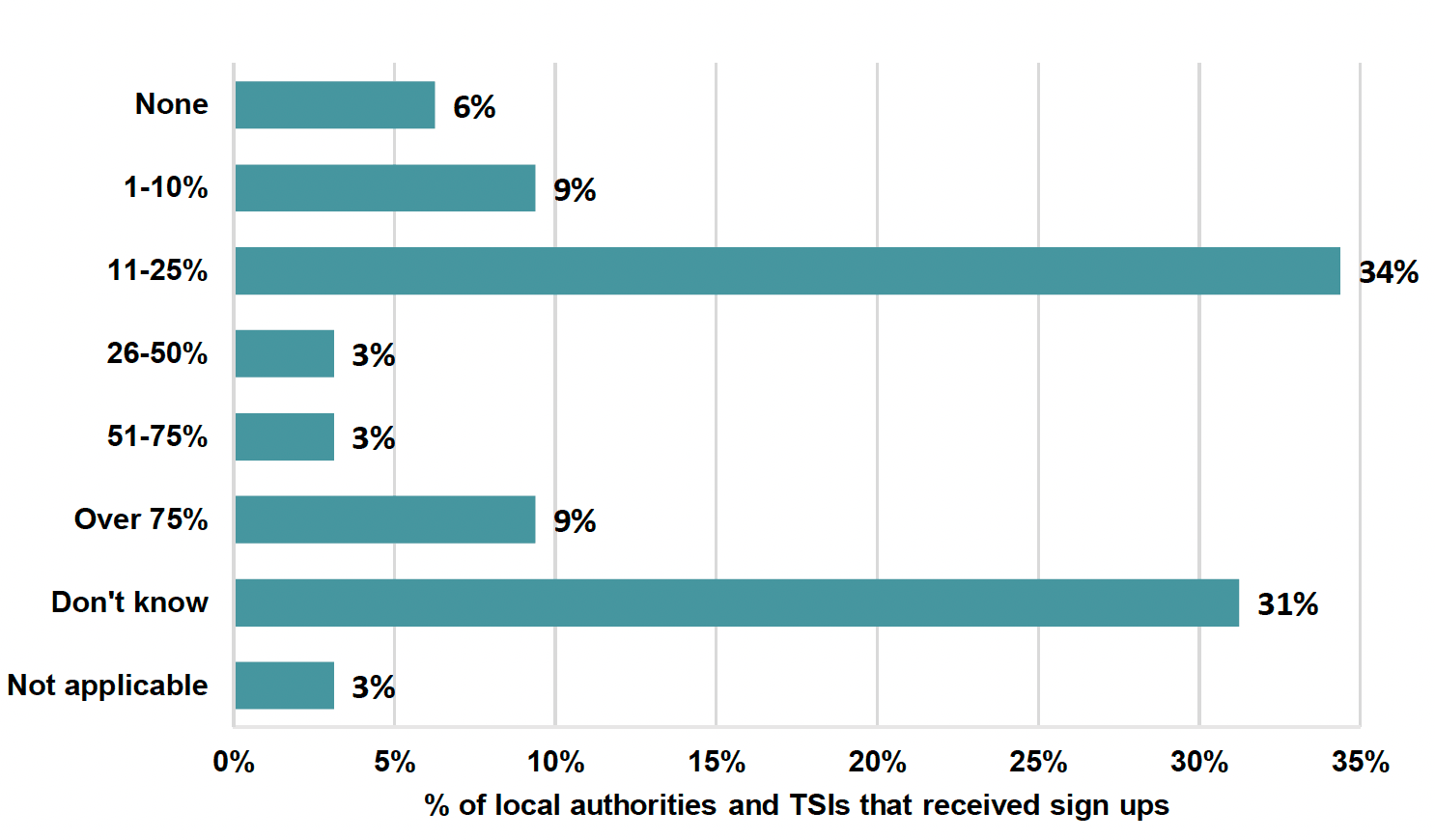
We also asked VIOs about their level of awareness of the Scotland Cares campaign, and whether they received any volunteers as a result of the campaign. Sixty-one percent of the VIO respondents said they were aware of the campaign, while 33% said they were not, suggesting that information about the campaign was only partially successful in reaching VIOs (Figure 5.6).
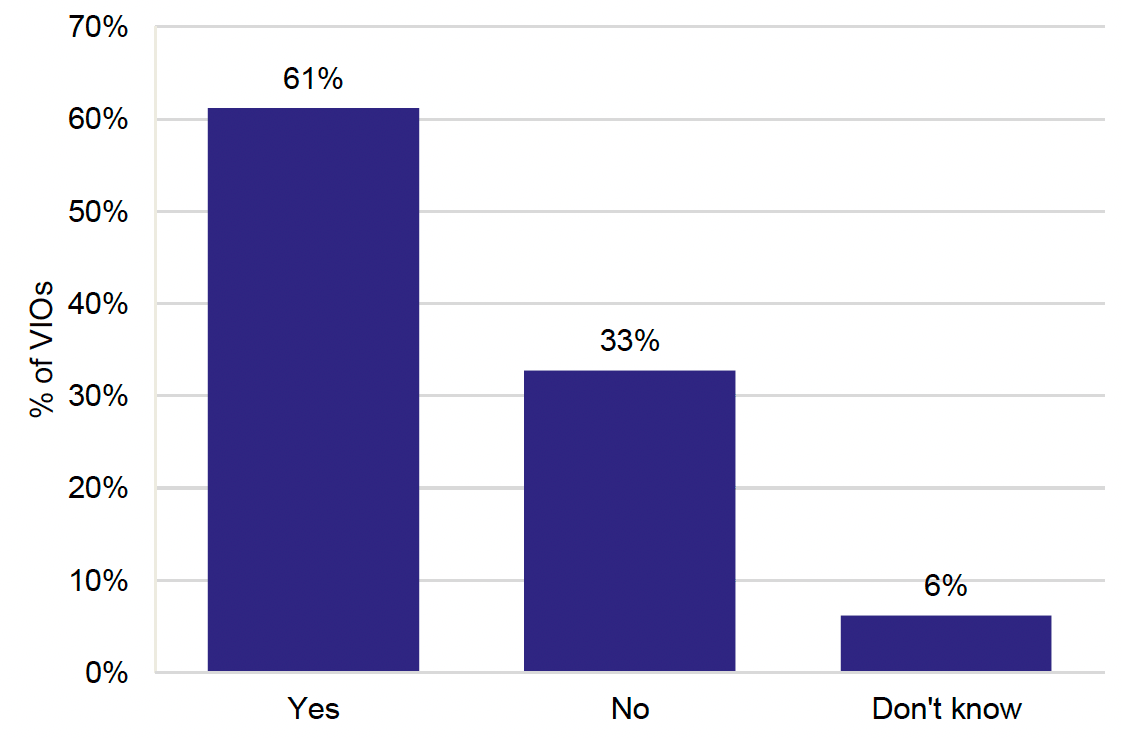
When VIOs that were aware of the campaign were asked whether any volunteers had started volunteering with their organisation as a result of Scotland Cares, 78% answered no, 16% said they did not know, and 5% said that they had received volunteers as a result (Figure 5.7).
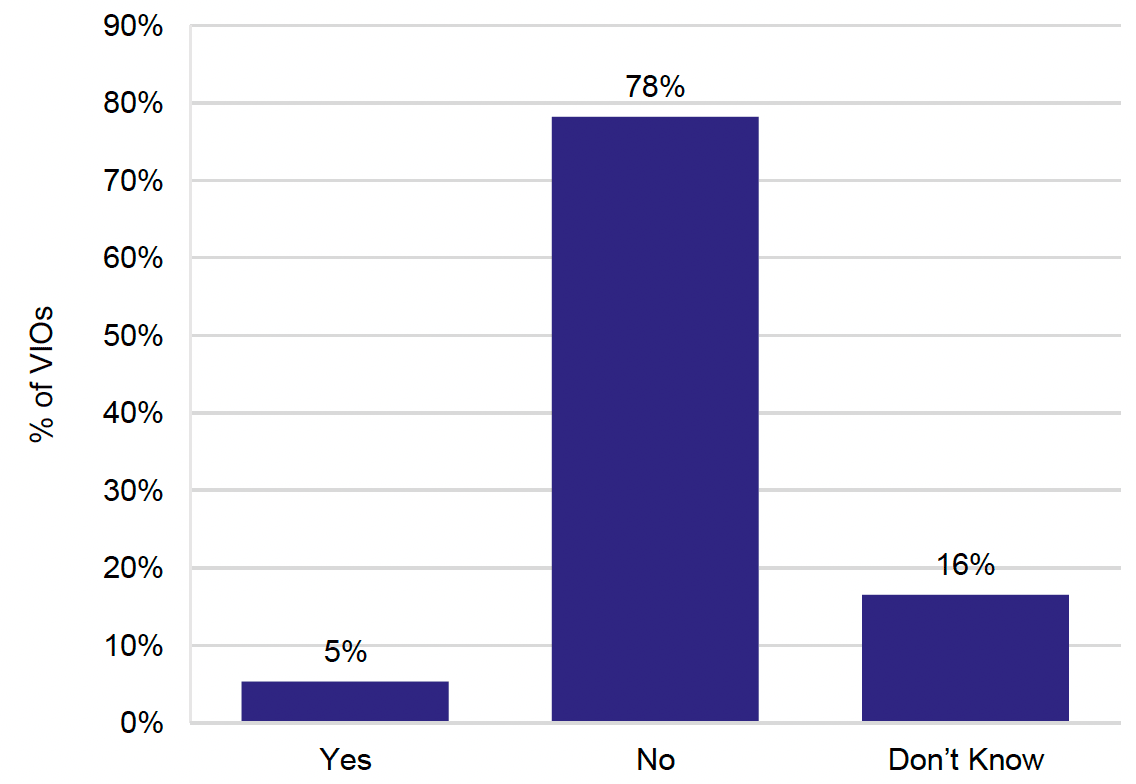
Where VIOs indicated that no volunteers had been placed within their organisations as a result of the campaign, they were asked to indicate the reasons for this. Of these organisations, 76% said that they did not need any more volunteers, and 8% said that they had received volunteers from elsewhere.
In summary, from the perspective of TSIs, the Scotland Cares campaign did not result in high numbers of volunteer placements, primarily because the level of formal volunteering opportunities that existed in local areas at the time was very low. Meanwhile, mutual aid groups had already gotten underway, and had successfully recruited large numbers of participants via social media channels.
'The main challenge was that [TSI] had already advertised and placed volunteers when the [Scotland Cares] appeal was launched. In addition the local informal or semi-formal volunteers structures were already well underway – people found their own ways to help.'
From a longer-term perspective, however, the campaign generated a large number of potential volunteers, many of whom have registered with volunteering mailing lists and databases within their local authority area, offering scope for future engagement as more formal volunteering opportunities open up. Efforts to maintain links with this large pool of potential volunteers could also form part of preparedness strategies for future emergency responses (see also Chapter 8).
Contact
Email: socialresearch@gov.scot
There is a problem
Thanks for your feedback